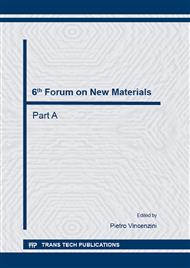[1]
Z. Zou, J. Ye, K. Sayama, H. Arakawa, Direct splitting of water under visible light irradiation with an oxide semiconductor photocatalyst, Nature. 414 (2001) 625–627.
DOI: 10.1038/414625a
Google Scholar
[2]
A. Fujishima and K. Honda, Electrochemical Photolysis of Water at a Semiconductor Electrode, Nature. 238 (1972) 37 - 38.
DOI: 10.1038/238037a0
Google Scholar
[3]
M. Gratzel, Photoelectrochemical cells, Nature. 414 (2001) 338-44.
Google Scholar
[4]
D. Jing, L. Guo, L. Zhao, X. Zhang, H. Liu, M. Li, et al., Efficient solar hydrogen production by photocatalytic water splitting: from fundamental study to pilot demonstration, Int J Hydrogen Energ. 35 (2010) 7087–7097.
DOI: 10.1016/j.ijhydene.2010.01.030
Google Scholar
[5]
D. Meissner, R. Memming, B. Kastening, D. Bahnemann, Fundamental problems of water splitting at cadmium sulfide, Chem Phys Lett. 127 (1986) 419–423.
DOI: 10.1016/0009-2614(86)80583-8
Google Scholar
[6]
F. Le Formal, M. Gratzel, K. Sivula, Controlling photoactivity in ultrathin hematite films for solar water-splitting, Adv. Funct. Mater. 20 (2010) 1099–1107.
DOI: 10.1002/adfm.200902060
Google Scholar
[7]
K. Sivula, F. Le Formal, and M. Gratzel, Solar water splitting: progress using hematite (α-Fe (2) O (3) photoelectrodes, ChemSusChem. 4 (2011) 432–449.
DOI: 10.1002/cssc.201000416
Google Scholar
[8]
I. Cesar, A. Kay, J.A. Gonzalez Martinez, M. Gratzel, Translucent thin film Fe2O3 photoanodes for efficient water splitting by sunlight: nanostructure-directing effect of Si-doping, J Am Chem Soc. 128 (2006) 4582–4583.
DOI: 10.1021/ja060292p
Google Scholar
[9]
A. Watanabe, H. Kozuka, Photoanodic properties of sol gel-derived Fe2O3 thin films containing dispersed gold and silver particles, J. Phys. Chem. B 107 (2003) 12713–12720.
DOI: 10.1021/jp0303568
Google Scholar
[10]
K. T. Ranjit, I. Willner, S. H. Bossmann and A. M. Braun, Lanthanide oxide-doped titanium dioxide photocatalysts: novel photocatalysts for the enhanced degradation of p-chlorophenoxyacetic acid, Environ. Sci. Technol. 35 (2001) 1544–1549.
DOI: 10.1021/es001613e
Google Scholar
[11]
X. Wang, J. C. Yu, Y. Chen, L. Wu, X. Fu, Development of Super-Hydrophilicity on Nitrogen-Doped TiO2 Thin Film Surface by Photoelectrochemical Method under Visible Light, Environ. Sci. Technol. 40 (2006) 2369-2374.
Google Scholar
[12]
A. Brambilla, A. Calloni, G. Berti, G. Bussetti, L. Duò, F. Ciccacci, Growth and Interface Reactivity of Titanium Oxide Thin Films on Fe, J. Phys. Chem. 117 (2013) 9229–9236.
DOI: 10.1021/jp400159j
Google Scholar
[13]
E. Borgarelio, J. Kiwi, F. Pelizzetti, M. Visca and M. Gritzel, Sustained water cleavage by visible light, J. Am. Chem. Soc. 103 (1981) 6324–6329.
DOI: 10.1021/ja00411a010
Google Scholar
[14]
J. Kiwi and M. Gritzel, Heterogeneous photocatalysis: enhanced dihydrogen production in titanium dioxide dispersions under irradiation. The effect of magnesium promoter at the semiconductor interface, J. Phys. Chem. 90 (1986) 637–640.
DOI: 10.1021/j100276a031
Google Scholar
[15]
A. Davidson and M. Che, Temperature-induced diffusion of probe vanadium(IV) ions into the matrix of titanium dioxide as investigated by ESR techniques, J. Phys. Chem. 96 (24) (1992) 9909–9915.
DOI: 10.1021/j100203a061
Google Scholar
[16]
Z. Luo, Q. H. Gao, Decrease in the photoactivity of TiO2 pigment on doping with transition metals, Journal of Photochemistry and Photobiology A: Chemistry. (1992) 367–375.
DOI: 10.1016/1010-6030(92)85202-6
Google Scholar
[17]
T. Kasuga, M. Hiramatsu, A. Hoson, T. Sekino and K. Niihara, Titania Nanotubes Prepared by Chemical Processing, Adv Mater. (1999) 11-130.
DOI: 10.1002/(sici)1521-4095(199910)11:15<1307::aid-adma1307>3.0.co;2-h
Google Scholar
[18]
L. Jing, S. Lan, Z. Hui-Fang, W. Cheng-Lin, D. Rong-Gui and L. Chang-Jian, Preparation and Photoelectrochemical Properties of Fe-doped TiO2 Nanotube Arrays, Journal of Electrochemistry 14 (2008) 213-217.
Google Scholar
[19]
X. H. Wang, J. G. Li, H. Kamiyama, M. Katada, N. Ohashi, Y. Moriyoshi and T. Ishigaki, Pyrogenic Iron (III)-Doped TiO2 Nanopowders Synthesized in RF Thermal Plasma: Phase Formation, Defect Structure, Band Gap, and Magnetic Properties, J Am Chem Soc. 127 (2005).
DOI: 10.1021/ja051240n
Google Scholar
[20]
A. Fujishima, K. Honda, Electrochemical Photolysis of Water at a Semiconductor Electrode, Nature. 238 (1972) 37 - 38.
DOI: 10.1038/238037a0
Google Scholar
[21]
M. Anpo, T. Shima, S. Kodama, Y. Kubokawa, Photocatalytic hydrogenaTiOn of propyne with water on small-particle titania: size quantization effects and reaction intermediates, J. Phys. Chem. 91 (1987) 4305–4310.
DOI: 10.1021/j100300a021
Google Scholar
[22]
H. Yamashita, S. Kawasaki, Y. Ichihashi, M. Harada, M. Takeuchi and M. Anpo, Characterization of Titanium−Silicon Binary Oxide Catalysts Prepared by the Sol−Gel Method and Their Photocatalytic Reactivity for the Liquid-Phase Oxidation of 1-Octanol, J. Phys. Chem. 102 (1998).
DOI: 10.1021/jp981343a
Google Scholar
[23]
M. Alam Khan, S. Ihl Woo, O. Bong Yang, Hydrothermally stabilized Fe(III) doped titania active under visible light for water splitting reaction, Int J Hydrogen Energ. (2008) 5345-5351.
DOI: 10.1016/j.ijhydene.2008.07.119
Google Scholar
[24]
K. J. Noh, B. R. Kim, G. J. Yoon, S. C. Jung, W. S. Kang and S. J. Kim, Microstructural Effect on the Photoelectrochemical Performance of Hematite-Fe2O3 Photoanode for Water Splitting, Electron Mater Lett. (2012) 345-350.
DOI: 10.1007/s13391-012-2007-0
Google Scholar
[25]
E. Noh, K. J. Noh, K. S. Yun, B. R. Kim, H. J. Jeong, H. J. Oh, S. C. Jung, W. S. Kang and S. J. Kim, Enhanced Water Splitting by Fe2O3-TiO2-FTO Photoanode with Modified Energy Band Structure, The Scientific World Journal (2013) 723201-723209.
DOI: 10.1155/2013/723201
Google Scholar
[26]
K. J. Noh, H. J. Oh, H. K. Ku, S. C. Jung, W. S. Kang, S. Park and S. J. Kim, Annealing Effect on the Microstructure and Electrochemical Properties of Fe2O3/H-TiNT/FTO Thin Film, Nanoscience and Nanotechnology 13 (2013) 1863-1866.
DOI: 10.1166/jnn.2013.6990
Google Scholar
[27]
H. J. Oh, K. J. Noh, B. R. Kim, W. S. Kang, S. C. Jung, and S. J. Kim. Fabrication of Fe2O3/TiO2 photoanode for improved photoelectrochemical water splitting, Jpn J Appl Phys. 52 (2013) ID 01AC15.
DOI: 10.7567/jjap.52.01ac15
Google Scholar


